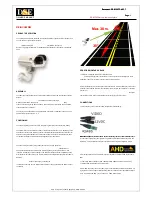
JPEG mode, 3488 x 2616 pixels, 1/160 sec., F5.0, ISO 200 equivalent
M
P
S
A
With 11 different shooting modes, the FinePix S9100 lets
you explore all the artistic parameters of photography.
Just turn the mode dial to “A” mode (Aperture Priority
Auto) or “S” mode (Shutter Priority Auto) and explore the
creation of professional photographic effects.
Allows you to
superimpose as
many images as
you like on the same frame.
The bright, easy-to-view interface displays a range of image data during shooting
and playback on the LCD monitor. In addition to shooting mode information, the
monitor also offers a real-time histogram display for confirmation of exposure
values. During playback, a convenient overexposure warning causes overexposed
highlight areas to blink, helping to ensure you've captured the picture you were
shooting for.
This convenient button gives you
one-touch access to frequently
used settings including image
size, ISO sensitivity, and FinePix
Color mode (Standard, Chrome,
and B&W).
Automatically captures three
consecutive shots in 1/3, 2/3
or 1 EV increments over and
under the set exposure.
The FinePix S9100 sports a bright and easy-to-see 2.0-inch LCD monitor that swivels vertically to let
you shoot from high and low angles with ease. And the monitor displays a live, real-time view that lets
you frame and compose your image right on the LCD. This expanded shooting leeway opens up new
options for capturing creative shots.
The FinePix S9100 offers full movie plus sound
recording. Its 30fps movie mode produces beautifully
smooth videos. Autofocus, auto-exposure, and zoom
functions all operate during video recording, assuring
that your subject stays in focus and properly exposed,
even under changing light conditions. And movie
quality approaches that of dedicated camcorders.
The refresh rate of the LCD monitor and TFT electronic
viewfinder (EVF) can be selected for optimum visibility,
with a choice of standard 30fps or an enhanced 60fps for
smoother viewing. The crisp, clear EVF also features
approx. 100% coverage, and provides you true TTL
framing and full on-screen shooting information.
Movie recording
B&W mode
The expanded shooting
freedom of a multi-angle LCD
Other functions
Sophisticated editing possibilities with CCD-RAW file format
Hyper Utility Software HS-V2
Included
Versatile shooting modes
Multi-exposure
function
Extensive shooting and image data displays
FinePix Photo button
Additional functions
Auto-exposure
bracketing
Multi-angle LCD monitor
RAW File Converter EX
Movie recording with sound
Easy-to-see
LCD monitor and EVF
Super Macro shooting
2-image display function
Windows
Required CPU
OS
RAM
Required hard-disk space
256MB or
more (512MB
recommended)
1GB or more
Macintosh
The Super Macro mode lets you move right in –
as close as 1cm from your subject. Close-ups
are richly detailed and razor sharp, turning
everyday objects into exciting visual images.
Pentium4, Celeron,
Pentium-M
Windows 2000 Professional Sp4,
Windows XP Professional SP1/SP2,
Windows XP Home SP1/SP2
Download manual for Hyper Utility Software HS-V2 at http://www.fujifilm.com/products/digital/lineup/s9100/images/hsv2.pdf
Power PC &
Intel Processor
Mac OS X (10.3.9-10.4.6)
Multi-exposure shooting
Histogram indication (shooting)
Mode dial indication (shooting)
Shooting information indication (playback)
Overexposed
Correct
Underexposed
Convenient for selecting
the most attractive
image, this feature
makes it possible to
compare results within
the RAW File Converter
EX environment. Image
analysis is supported
with histogram highlight
warnings and other
sophisticated functions.
Picture-in-Picture (P-in-P) function
White balance (Auto/Manual/Custom)
Continuous shooting
Dual media slots for xD-Picture Card™ and CompactFlash/Microdrive™
Three exposure control
Aperture Priority Auto
A
Shutter Priority Auto
S
Picture Stabilization
This function allows you
to precisely control the
brightness or contrast
of the image by
confirming image data
on the preview screen.
In addition to standard
light source settings, this
function allows you to set
the white balance by
picking a gray spot in the
image or setting the color
temperature.
This function allows you to
control brightness of the
image by specifying optimal
settings between –1.0 and
+2.0 in 1/6 EV increments
according to histogram
display and alarm indications.
Tone curve control
White balance control
Brightness control by
exposure compensation






















